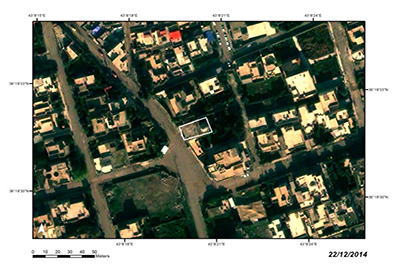
Analysis of satellite imagery reveals the unprecedented scope of destruction of historical monuments in Mosul
Analysis of satellite imagery reveals the unprecedented scope of destruction of historical monuments in Mosul
Thu Feb 25 11:30:00 CET 2016

In reaction to serious threats to the Mosul architectural sites from ISIS (Daesh), a team of Czech scientists from the Oriental Institute of the Czech Academy of Sciences in Prague, has launched the project "Monuments of Mosul in Danger". The aim is to document and research Mosul architectural sites that have been destroyed by this terrorist organization since June 2014. As the first output of the project the team has released an interactive map of monuments destroyed thus far, which was created through analysis of satellite imagery.
The map is linked to profiles of individual monuments, which contain satellite images documenting the scope of the destruction.
The scope of the destruction has proved to be strikingly extensive. By the end of August 2015 (when the most recent satellite image analysed was taken), 38 monuments were detected that had been either ruined or totally razed to the ground (in some cases, cleared spaces were paved over to be used as carparks). Five of the destroyed monuments have not been identified so far. Of the 33 identified monuments, only two are of Christian origin (al-Tahra Syriac Ortodox Church and the partially ruined Monastery of St. George); the remaining are Islamic buildings of diverse architectural types, such as mosques, madrasas, and mausolea and shrines of venerated personages, native to or associated with the town. Several graveyards have also been obliterated. Only four of the 31 Islamic monuments were founded in the 20th century. Of the remainder, almost two thirds originated in the Atabeg Period (ca. 12-13th century AD), and the last third in the Ottoman Period (16-19th century AD).
On the list, there are many architectural landmarks that once formed a unique panorama of the city (e.g. the Mosque of the Prophet Yunus in Nineveh, the Shrine of Imam Yahya ibn al-Qasim, the Mosque of the Prophet Seth, etc.), whose destructions have been extensively reported in the media. On the contrary, destructions of other, rather modest pieces of architecture have gone almost unnoticed. Among them, the collection of mosques and shrines erected during the reign of the Mosul atabeg Badr al-Din Lu’lu’ (died AD 1259), once representing the unique „Mosul School“ of medieval architecture, has dissappeared almost completely.
Mosul architecture has only been marginally researched by Western scholars. The first and only systematic survey of Islamic, Christian, and Jewish monuments in Mosul was conducted by the German archaeologist Ernst Herzfeld in the beginning of the 20th century. The archaeological research of Iraqi scholars remains largely unrecognized. Because of this, we are in fact not aware of what architectural and artistic treasures the world cultural heritage has been deprived of. In order to fill in this information gap, the Czech team seeks to collect all possible visual (photographs, documentary films) and plan documentation as well as historical and recent site descriptions to create precise profiles of the destroyed monuments. The collected data would be of great use when circumstances allow for the reconstruction of Mosul’s lost heritage.
The list and interactive map of destroyed monuments of Mosul are accessible at: http://monumentsofmosul.com
Project Team Members:
Ass. Prof. Karel Nováček
Dr. Miroslav Melčák
Dr. Lenka Starková
Dr. Ondřej Beránek


